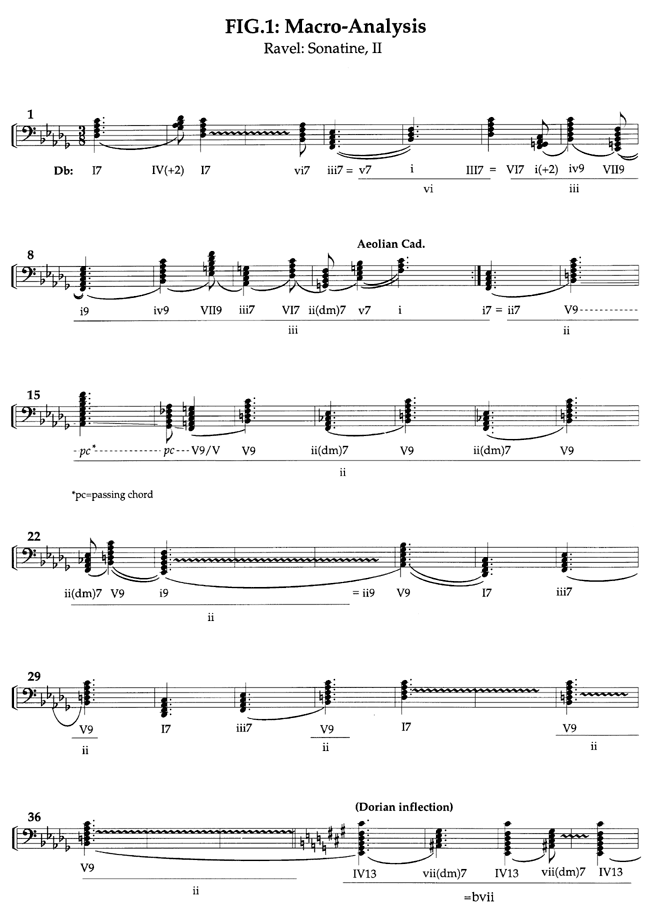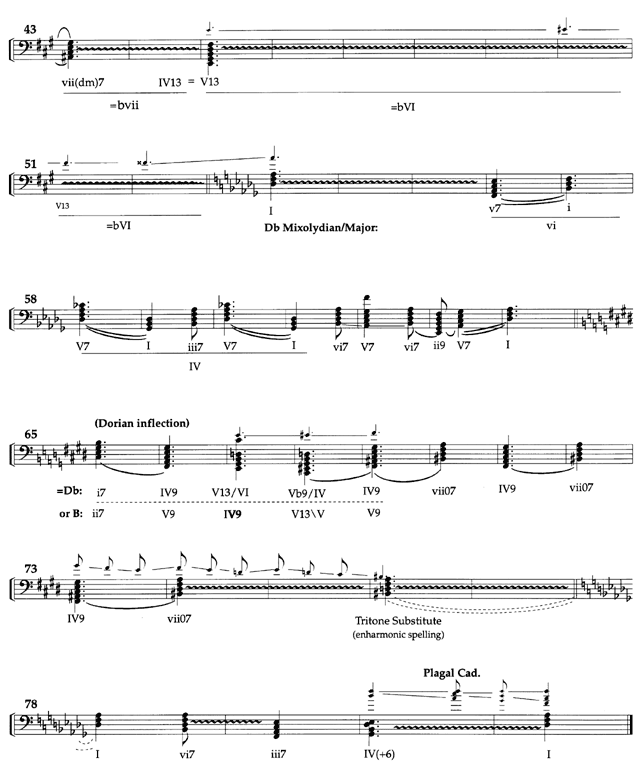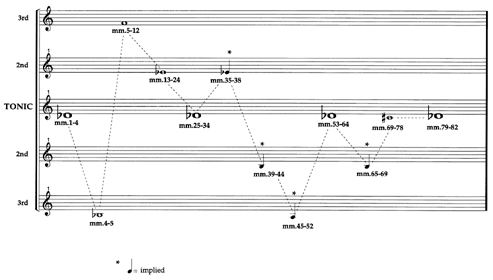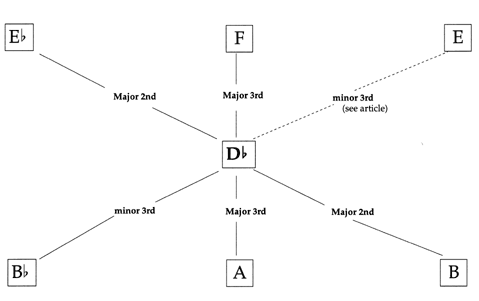
Figure 1. Macro Analysis Ravel: Sonatine, II.

Figure 1, concluded.

Figure 2. Ravel: Sonatine, II. Tonal Centers

Figure 3. Ravel: Sonatine, II. Tonal Axis
Musical Insights, Vol. 1 (Spring 1997) [Prev] [Next] [MACRO] [Journal Home] [Submissions]
The "Mouvement de Menuet" of Maurice Ravel's Sonatine exhibits many of the more recognizable characteristics of "Impressionistic" music: "extended" harmonic vocabulary; fluid, motivically-based melodic lines; harmonic progression by thirds; and modally-inflected melodic/harmonic writing, to name a few. The piece also contains tonal centers that frequently appear to be either ambiguous or altogether absent--yet another characteristic of "Impressionism." This essay will attempt to explain the extant tonal centers in the movement, en route to developing a model consisting of a balanced tonal axis, with the aid of macro-analytical techniques. The reader may wish to periodically consult the complete macro analysis in figure 1 during the course of the discussion.
As implied by the title, Ravel's Sonatine is a neo-Classical work. Thus, one might expect to find the harmonic motion of the piece to be relatively traditional. To some extent, this is entirely true. Indeed, the first twelve measures of the piece involve extensive use of fifth progressions which effect a modulation from D-flat major to F minor by m. 12. In mm. 4-5, the key of B-flat minor is briefly encountered in passing. The use of Aeolian mode throughout this passage "softens" the tonal pull of the harmonic motion by minimizing any strong leading tone implications. In both mm. 5 and 12, Ravel punctuates new tonal centers by incorporating an appropriate "5-1" ("sol-do") figure in the bass voice, in the respective keys of B-flat minor and F minor. This punctuation helps to clarify and reinforce these keys, which emerge as initial elements in an unfolding tonal axis revolving about D-flat, which is clearly the overall tonal center of the piece.
In m. 13, a transitory passage begins, leading from F minor to the return of the opening theme in E-flat minor in m. 23. Root motion is very simple, primarily focusing upon a "stalled" repeated progression of F to B-flat chords. Yet, through the subtle and gradual introduction of chromatic alterations, Ravel is able to prepare the arrival of the new E-flat key center. Hindsight would indicate that mm. 13-14 be analyzed as ii7 to V7 in E-flat minor. Yet, at the local level, the passage would appear to be Dorian inflected (i7 to IV9 in F minor). A temporary "pull" to B-flat is established in m. 16, with the introduction of a V9 chord in that key, but the B-flat ninth chord in the succeeding measure points ahead to E-flat instead. The chromatic alteration of C to C-flat in m. 18 helps complete the move to E-flat minor, as a diatonic ii(dm)7 to V9 progression in that key is thus established, and stated twice more before eventually resolving to the expected tonic in m. 23. The return of the initial theme in this measure is not entirely convincing, however, as the opening "1-5" melodic motive signaling the theme occurs on the fifth and ninth of the tonic chord this time, rather than on the expected tonic and fifth. The effect is one of weakening the theme and the overall tonal center, affirming that this passage is still part of a formal transition eventually leading back to the center of the tonal axis, D-flat, in m. 27. Yet, even with the re-assertion of D-flat, the earlier F-to-B-flat progression retains importance, as the progression is heard twice, concluding with an extended (and ultimately unresolved) V9 chord (in E-flat) in mm. 35-38. Thus, the return to the original tonic is a brief one. Further tonal "adventures" await.
In m. 39, the B-flat ninth chord from mm. 35-38 resolves not to the expected E-flat, but instead to E-natural. E and A-sharp chords oscillate through m. 45. This oscillation symmetrically "frames" the center of the tonal axis, as E is an enharmonic minor third above D-flat, while A-sharp is an enharmonic minor third below D-flat. Tonally, this passage is somewhat ambiguous, but the music has striking aural parallels to mm. 17-22. In that earlier passage, oscillating chords were eventually aurally defined as ii(dm)7 to V9 in E-flat, the tonal area a major second ABOVE the D-flat tonal axis. The ear "recalls" this as an aid to understanding mm. 39-45, interpreting the harmonic motion E13 to A-sharp(dm)7 as IV13 to vii(dm)7 in B, which is a major second BELOW the D-flat tonal axis. While a tonic chord in B never arrives, there is a strong feeling that one is to be anticipated. Thus, the interrelationships that exist between the two analagous passages extend to a tonal level, as each passage balances the other tonally around the central D-flat axis. At the same time, the E and A-sharp chords of the second passage balance one another around the central axis at the local level, as well.
The extended E13 chord which begins in m. 45 implies V13 in A major, and its prolongation over the course of eight measures heightens the expectation that the chord will indeed resolve to A. However, A major as a tonic is evaded through chromatic motion of inner voices, effecting an enharmonic return to D-flat major by m. 53. At this point, the original theme is stated, initially in Mixolydian mode. Like the implied B tonal center in mm. 39ff, the implied tonal center of A major in this passage is not to be overlooked. Contextually, E bass pedal tones in mm. 46 and 48 emphasize the dominant quality of the E13 chord and draw the ear to the anticipated resolution. Although the expected A tonic never materializes, the influence of A in the passage is nevertheless substantiated.
The arrival of this A-centered musical passage completes and fully balances the tonal axis for the piece (see figs. 2 and 3). D-flat is centered within an axis consisting of tonal areas an enharmonic major second above and below D-flat (E-flat minor, B minor), and an enharmonic major third above and below D-flat (F minor, A major). While B major is intimated again ca. m. 65, chromatic alterations in the succeeding passage reassert C-sharp minor (enharmonic with D-flat), and the movement ends conclusively with a strong statement of a prominent thematic motive in D-flat major.
But what of the tonal area B-flat, which was the very first key encountered after the opening tonic (mm. 4-5)? Realistically, there is no passage in E (F-flat) that would counterbalance B-flat on the tonal axis a minor third above the overall tonal center. Yet, further examination of the passage beginning in m. 39 will nevertheless substantiate the incorporation of E into our tonal axis model. Recall that this passage consists of oscillating E and A-sharp chords, which indeed DO frame the tonal axis at the interval of a minor third. This passage occurs at the very midpoint of the piece (which is 82 measures long). Also, the passage marks a shift in secondary tonal centers from "flat" keys (B-flat minor, F minor, E-flat minor) to "sharp" keys (B minor, A major, C-sharp minor*), as shown in figure 3. Thus, even though E is never directly encountered as a tonic, it is highly significant for its role in dividing the piece into two halves temporally and tonally (as determined via the "Circle-of-Fifths"). Together with A-sharp, E adds substantially to the structure of the movement, and for this reason, its inclusion in the tonal axis can be justified.
In conclusion, a fuller understanding of the tonal centers in Ravel's Sonatine (second movement) can be obtained through an examination of fully realized keys, implied tonics, and chords serving as "structural dividers". This understanding is facilitated through the use of macro analysis, which relies upon the listener's perceived hearing of a given musical passage, as well as that listener's pursuant sense of tonal anticipation. In this piece, macro analysis facilitates the "unveiling" of an elegant, symmetrically balanced tonal axis.

Figure 1. Macro Analysis Ravel: Sonatine, II.

Figure 1, concluded.

Figure 2. Ravel: Sonatine, II. Tonal Centers

Figure 3. Ravel: Sonatine, II. Tonal Axis